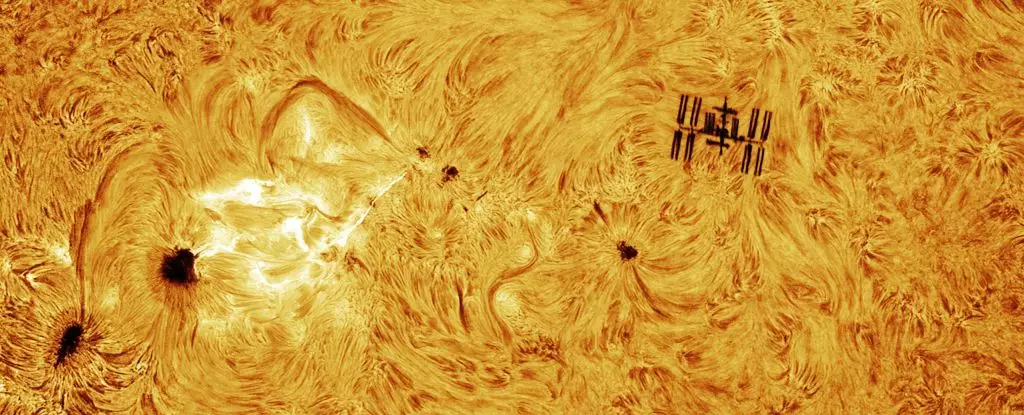Photographing the International Space Station (ISS) as it crosses the face of the Sun or Moon is a formidable challenge that only a dedicated few astrophotographers undertake. The ISS, hurtling around Earth at about 28,000 kilometers per hour, appears as a tiny, fleeting silhouette against these colossal celestial bodies. Capturing such moments requires precise timing, extensive preparation, and a deep understanding of orbital mechanics combined with expert camera technique. It is a pursuit where luck and skill meld to produce images that are nothing short of breathtaking.
Andrew McCarthy, an astrophotographer based in Arizona, exemplifies this rare blend of expertise and fortune. His recent image, taken in the Sonoran Desert, stands out not only because it captures the ISS transit but also because it serendipitously includes a medium-sized solar flare erupting from the Sun’s surface. This unexpected confluence of events elevates the photograph from a typical transit shot to a profound visual narrative about the dynamic nature of our solar neighborhood.
Beyond the Transit: A Window into Solar Power
Solar flares are intense bursts of radiation caused by the reconfiguration of magnetic fields near sunspots. While they present a hazard for spacecraft electronics and increase radiation exposure for astronauts temporarily, they are spectacular demonstrations of the Sun’s simmering energy. McCarthy’s image, which simultaneously captures one of these flares with the ISS in transit, encapsulates a fleeting cosmic interplay rarely documented so vividly.
What makes this photo extraordinary is not only the timing but the context. The ISS orbits at roughly 400 kilometers above Earth—far too distant to be impacted directly by the flare—but its shadow crossing the blazing solar disc creates a poignant metaphor. The image subtly reminds us how human technology and nature’s primal forces coexist, separated yet intertwined in the vastness of space. It is a snapshot that tells a layered story about vulnerability, ambition, and progress.
Technical Mastery Under Harsh Conditions
McCarthy’s approach to capturing this image reveals his mastery over both technology and environment. Working in the extreme heat of the Arizona desert, he cooled his telescopes with ice packs and refrigeration units to prevent thermal distortion, a crucial step for maintaining image clarity. He didn’t rely on a single frame; instead, he created a composite mosaic by continuing to photograph the Sun after the ISS transit. This meticulous approach allowed him to fill in intricate details of the solar disc, creating a visually comprehensive and detailed panorama.
Furthermore, McCarthy incorporated elements from the 2024 solar eclipse to accentuate the Sun’s chromosphere against a dark background, enhancing contrast and storytelling. This creative decision transformed the raw astronomical data into an evocative piece of art that speaks to both the ephemeral and eternal aspects of our star.
Kardashev Dreams: Symbolism in Astrophotography
The astrophotographer named his masterpiece “Kardashev Dreams” after Nikolai Kardashev, a Soviet astronomer who devised a scale measuring the technological advancement of civilizations based on their energy consumption—from planetary to galactic scales. This concept aligns perfectly with the powerful imagery McCarthy conjured: the ISS, a testament to humanity’s burgeoning spacefaring capabilities, silhouetted against an energetic solar outburst blazing with raw cosmic power.
By referencing the Kardashev scale, McCarthy posits this image as symbolic of humanity’s potential to transcend current technological limits. It reflects the optimism of space exploration and our tentative but hopeful first steps toward becoming a truly advanced civilization capable of harnessing stellar-scale energies.
Inspiration and Invitation for Aspiring Astrophotographers
McCarthy’s achievement is not merely about producing a stunning picture; it serves as an inspiration to the wider community of astronomy enthusiasts and photographers. With tools like Transit Finder, anyone equipped with patience, expertise, and a bit of luck can attempt to capture their own ISS transits. Yet, McCarthy’s work highlights that exceptional astrophotography demands dedication and creativity far beyond basic equipment or timing.
This image encourages us to look at space not just as a distant frontier but as an ongoing dialogue between technology, human curiosity, and the natural dynamism of the cosmos. The extraordinary cosmic moments he immortalized remind us that, despite the vastness and forces often beyond our control, our gaze upward continues to push the boundaries of discovery and artistic expression.

